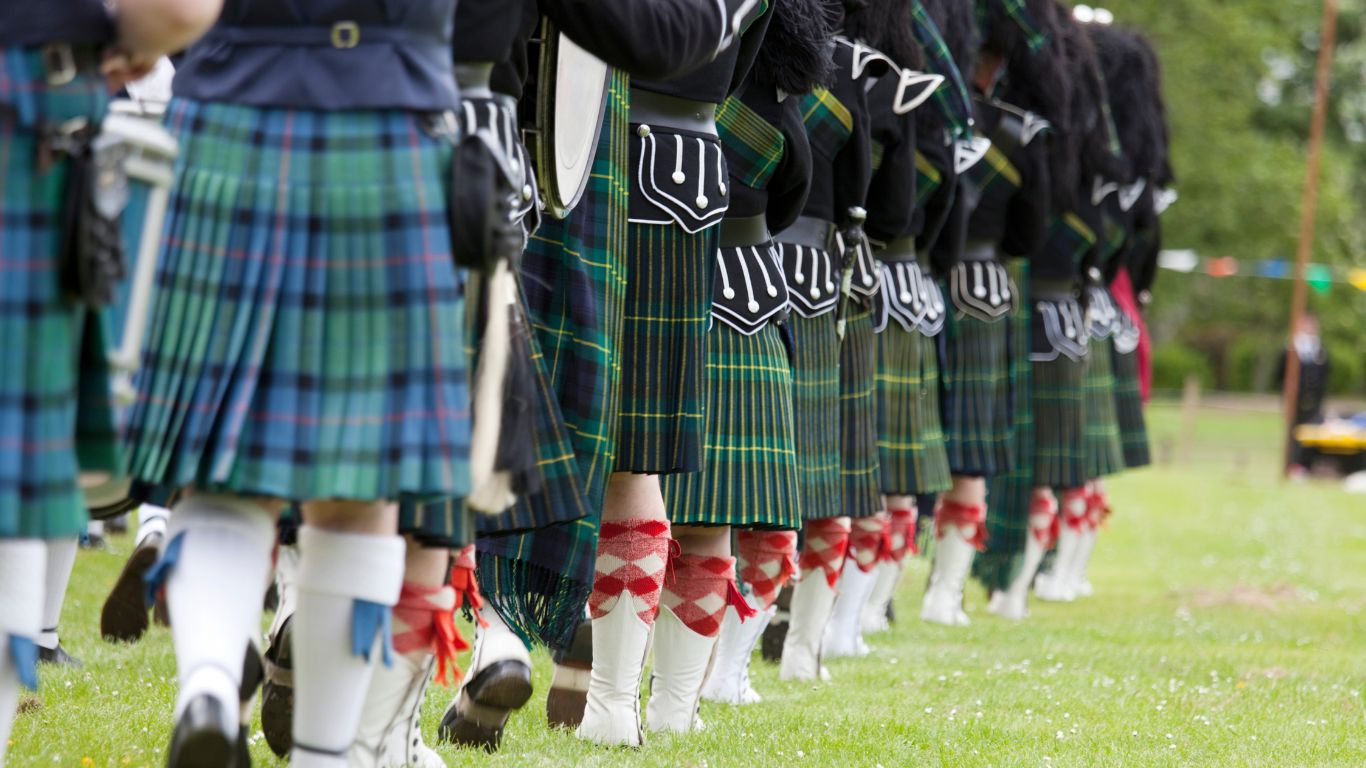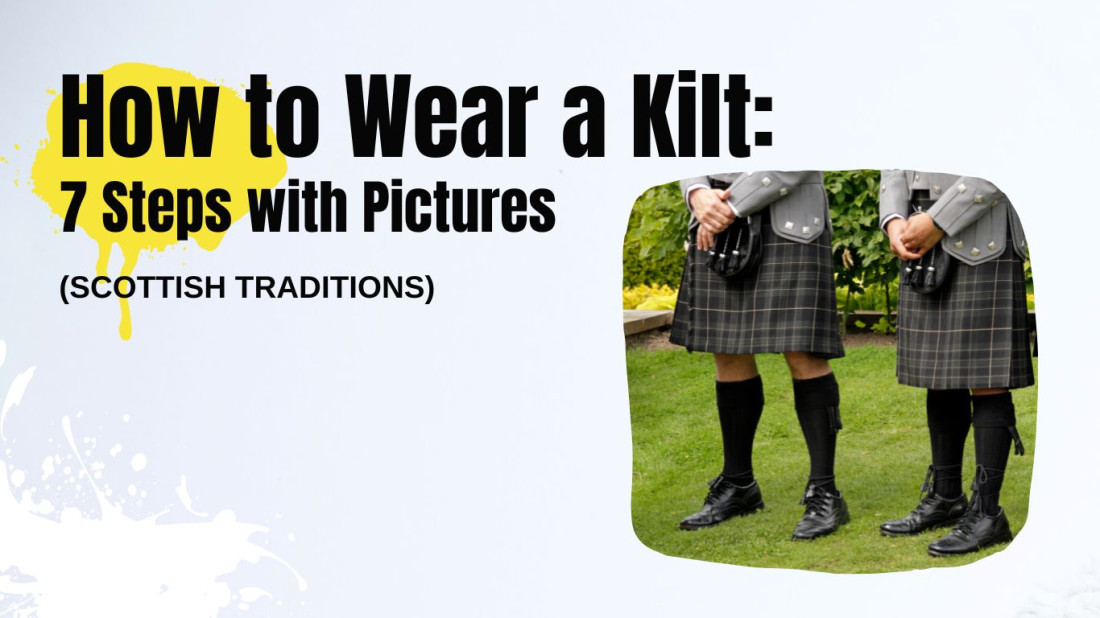The kilt, a distinctive piece of clothing hailing from Scotland, is not merely an article of clothing; it's a symbol of Scottish heritage, culture, and tradition. Wearing a kilt is more than just donning attire; it's an act of embracing history and connecting to the land of tartans, bagpipes, and rugged landscapes.
In this guide, we will walk you through how to wear a kilt casually, step by step, while delving into this iconic garment's rich history and significance.
Whether you're looking for a laid-back way to showcase your heritage or a comfortable yet stylish outfit choice, learn how to wear a kilt like a true Scotsman:
Understanding the Kilt: A Brief History

Knowing its rich historical context is essential to fully appreciate the art of wearing a kilt. The origins of the kilt can be traced back to the 16th century when Scottish Highlanders adopted it as a practical garment ideally suited for their demanding and rugged way of life.
Initially, kilts were rudimentary: long swaths of tartan fabric were draped around the body and secured with a belt. These early kilts served not only as protection against the elements but also as versatile clothing, allowing for freedom of movement across the challenging terrains of Scotland.
As time advanced, the kilt underwent a metamorphosis, transcending its functional beginnings to evolve into a potent symbol of Scottish identity and pride. It became a tangible representation of a clan's heritage, with distinct tartan patterns signifying various affiliations.
The kilt's journey from practicality to emblematic status underscores its enduring significance in the annals of Scottish culture. Today, understanding these historical underpinnings provides invaluable insights into the various ways to wear a kilt, honoring its functional history and its role as a revered cultural artifact.
Choosing the Right Kilt
Before mastering how to wear a kilt, a crucial step is selecting the perfect one. Kilts boast an array of tartan patterns, each a nod to distinct clans or regions. For those with Scottish roots, delving into family tartans can be rewarding. Equally, opting for a universal tartan that holds personal resonance is fitting.
The choice extends beyond patterns, encompassing styles; be it traditional or modern kilts. The fabric weight is paramount, factoring in both occasion and weather. Learning how to wear a great kilt is an art, but the first brushstroke lies in choosing a kilt that resonates with your lineage, style preferences, and the demands of the moment, be it the classic elegance of a Great Kilt or a contemporary twist.
Gathering the Essentials
Knowing essential accessories is mandatory if you want to know how to properly wear a kilt. The ensemble is harmonized with a sporran, a waist-worn pouch with historical significance, blending style and utility.
A kilt pin, a decorative flourish, adds elegance and secures the kilt's layers, ensuring an immaculate presentation. The belt acts as a linchpin, maintaining a snug fit and poised posture. Completing the look are hose, knee-length socks tied intricately to the ensemble.
These accessories, more than just aesthetic enhancements, offer functional value: the sporran holds essentials, and the kilt pin stabilizes, merging tradition and modernity.
Preparing to Wear the Kilt
Embarking on the process, start by adorning a modest shirt or undershirt. Transitioning seamlessly, fasten your hose and employ garters for a secure fit. With care, lay the kilt on an even plane—pleats cascading down the back, aprons gracing the front.
Precision is paramount as you step into this timeless garment: align the pleats masterfully along the rear. Finally, as the kilt envelops your form, an essential hallmark is comfort—the snug embrace resting harmoniously upon your waist. What is worn under a kilt? It varies with personal choice.
Through this artful sequence, the kilt becomes not just attire but a portal into heritage and culture, a fusion of history and contemporary appreciation.
Buckling Up: Securing the Kilt
After draping the kilt around your waist, secure it by fastening the leather belt's buckles—a delicate balance between a snug fit and comfortable ease. Now, the kilt pin takes center stage, a dual-purpose embellishment.
It is positioned thoughtfully on the right side and adds a dash of finesse and tradition. But its significance runs deeper: safeguarding the kilt's layers, maintaining pleats' alignment, and bestowing an aura of authenticity.
If you know how to wear a kilt pin, you can effortlessly merge style with functionality!
Adding the Sporran and Accessories:
Affix the sporran to the belt, allowing it to dangle at the heart of the front apron gracefully. This accessory embodies duality: it's both practical and ornamental. Seamlessly integrating function and aesthetics, the sporran serves as a storied companion. However, achieving equilibrium is essential—ensure its placement is comfortable and avoids undue weight.
Completing the ensemble, embrace suitable footwear, like ghillie brogues or other traditional shoes. This final touch seamlessly marries heritage and style, underscoring the meticulous artistry of donning a kilt.
Harmonized with a sporran and the proper footwear, the ensemble evokes a tangible connection to Scottish culture and tradition. Knowing how to wear a kilt and accessories can help you learn more about the amazing history of this land.
If you are struggling to find the perfect wedding kilt, Scottish kilt, or Irish kilts and its accessories, Super Kilts has it all!
Final Touches and Proud Stride:
With the kilt ensemble harmoniously in place, allocate a moment for thorough adjustments. Verify the kilt's comfort, the pleats' pristine arrangement, and the sporran's precise alignment. As you stand, radiate self-assurance, reflecting the proud heritage embodied by the kilt.
Each element encapsulates a legacy transcending time, a fusion of culture and personal expression. Allow the ensemble to embrace you as you embody its legacy—walk purposefully, head held high, embracing the profound tradition that the kilt symbolizes, a tangible link to Scotland's rich past, and a declaration of your connection to an enduring history.
How to put on a kilt will no longer be a problem for you!
FAQ's:
Who Can Wear a Kilt?
Wearing a kilt is not limited to a specific group; it's a cultural symbol that transcends boundaries. While historically associated with Scottish heritage, the kilt has evolved into a cherished garment worn by people worldwide.
Scots and non-Scots embrace kilts as a nod to tradition, style, or personal connection. Whether you have ancestral ties to Scotland or admire its culture, anyone can wear a kilt. The kilt serves as a unifying thread, weaving together a diverse tapestry of individuals who share a reverence for the kilt's history and significance.
When to Wear Black Watch Tartan?
The Black Watch tartan, a classic and versatile pattern, can be worn for various occasions. Rooted in Scottish military history, this tartan's deep green and blue hues evoke a sense of elegance. It's well-suited for formal events, such as weddings or evening galas, where its timeless charm adds a touch of sophistication.
The Black Watch tartan also seamlessly transitions to more casual settings, making it ideal for everyday wear or semi-formal gatherings. Its adaptability ensures this tartan is a steadfast symbol of heritage and refinement regardless of the event.
Who Can Wear Royal Stewart Tartan?
The Royal Stewart tartan is one of the most recognizable and widely worn tartans and holds a special connection to Scottish royalty. Its vivid red hue and bold pattern make it a statement choice. While historically associated with the Royal Family, this tartan has transcended its origins.
Today, anyone can proudly wear the Royal Stewart tartan, reflecting a shared appreciation for its regal history. It's often a popular choice for celebrations, family events, or simply as an everyday fashion statement. Wearing the Royal Stewart tartan symbolizes a link to Scotland's past and a celebration of its enduring influence on global culture.
Why Do Scottish Men Wear Kilts?
Scottish men wear kilts as a homage to their heritage, preserving centuries-old traditions. Kilts symbolize pride in Scottish culture and identity. The attire's historical significance, including its connection to clans and battles, cements its role as a cherished emblem of Scotland's past and present.
Conclusion:
Wearing a kilt transcends mere clothing; it's a profound symbolic gesture, forging a connection with Scotland's captivating history and resilient traditions. Each facet of this attire is a portal to a bygone era, a tapestry interwoven with stories of valor and cultural richness.
Every step in this ritual carries weighty significance. With its pleated folds, the kilt evokes the Highlands' rugged landscape. Donning it is an embrace of time-honored practices and a pledge to safeguard the legacy. By enveloping oneself in the art of wearing a kilt, an indelible connection to history is forged, a seamless transition from past to present.
This tradition, steadfast across centuries, continues to flourish. Wearing the kilt isn't a solitary act; it's an immersion into a living legacy. With each kilt, the torch of tradition is carried forward, acknowledging a heritage that refuses to fade.
The next time you don this iconic attire, recall these steps etched in heritage. Wear it not merely as fabric but as an emblem of pride, a homage to Scottish ancestry, and an emblem of the timeless spirit that endures through the kilt's folds.














